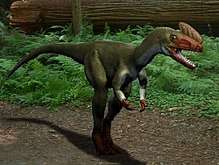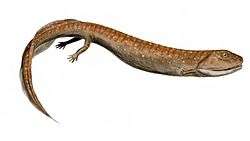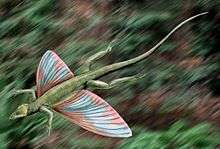1926 in paleontology
Paleontology or palaeontology is the study of prehistoric life forms on Earth through the examination of plant and animal fossils.[1] This includes the study of body fossils, tracks (ichnites), burrows, cast-off parts, fossilised feces (coprolites), palynomorphs and chemical residues. Because humans have encountered fossils for millennia, paleontology has a long history both before and after becoming formalized as a science. This article records significant discoveries and events related to paleontology that occurred or were published in the year 1926.
| |||
|---|---|---|---|
Angiosperms
Newly described angiosperms
| Name | Novelty | Status | Authors | Age | Unit | Location | Notes | Images |
|---|---|---|---|---|---|---|---|---|
|
Sp nov |
Valid |
Knowlton |
Acer | |||||
Conodonts
| Name | Status | Authors | Location | Images | |
|---|---|---|---|---|---|
| Ancyrodella[3] |
Valid taxon |
||||
Amphibians
| Name | Authors | Age | Location | Notes | Images |
|---|---|---|---|---|---|
| Crassigyrinus | Watson | 322 Million years ago | The thick Tadpole. |
Newly named basal diapsids
| Name | Status | Authors | Location | Notes | Images | |
|---|---|---|---|---|---|---|
| Coelurosauravus[4] |
Valid taxon |
A weigeltisaurid. an gliding Reptile. |
||||
Dinosaurs
Newly named dinosaurs
Data courtesy of George Olshevsky's dinosaur genera list.[5]
| Name | Novelty | Status | Authors | Age | Unit | Location | Notes | Images |
|---|---|---|---|---|---|---|---|---|
| Proceratosaurus[6] | Gen. nov. | Valid | Friedrich von Huene | Middle Jurassic (Bathonian) | Forest Marble Formation | A proceratosaurid tyrannosauroid theropod. The type species is Megalosaurus bradleyi. |  | |
| Rhoetosaurus[7] | Gen. et sp. nov. | Valid | Albert Heber Longman | Middle Jurassic (Aalenian-Bajocian) | Unknown | A basal gravisaurian sauropod. The type species is Rhoetosaurus brownei. | ||
Synapsids
Non-mammalian
| Name | Status | Authors | Age | Unit | Location | Notes | Images |
|---|---|---|---|---|---|---|---|
|
Junior synonym |
Haughton |
A junior synonym of Gorgonops. |
|||||
|
Junior synonym |
Haughton |
Late Permian |
A junior synonym of Aelurognathus. | ||||
References
- Gini-Newman, Garfield; Graham, Elizabeth (2001). Echoes from the past: world history to the 16th century. Toronto: McGraw-Hill Ryerson Ltd. ISBN 9780070887398. OCLC 46769716.
- Wolfe, J.A.; Tanai, T. (1987). "Systematics, Phylogeny, and Distribution of Acer (maples) in the Cenozoic of Western North America". Journal of the Faculty of Science, Hokkaido University. Series 4, Geology and mineralogy. 22 (1): 1–246.
- A classification of the toothlike fossils, conodonts, with descriptions of American Devonian and Mississippian species. EO Ulrich and RS Bassler, 1926
- Piveteau, J. 1926. Contribution to the Study of the Lagoonal Formations of Northwest Madagascar. Bull. Soc. Géol. Fr. (4), XXVI: p. 3.
- Olshevsky, George. "Dinogeorge's Dinosaur Genera List". Retrieved 2008-08-07.
- Huene, F. (1926a). "On several known and unknown reptiles of the order Saurischia from England and France". Annals and Magazine of Natural History. 17 (9): 473–489.
- Longman, H.A. (1926). "A giant dinosaur from Durham Downs, Queensland". Memoirs of the Queensland Museum. 8: 183–194.

